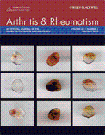Evidence that Dkk-1 is dysfunctional in ankylosing spondylitis
Abstract
Objective
Dkk-1 is an inhibitory molecule that regulates the Wnt pathway, which controls osteoblastogenesis. This study was undertaken to explore the potential role of Dkk-1 in ankylosing spondylitis (AS), a prototypical bone-forming disease.
Methods
Serum Dkk-1 levels were measured in 45 patients with AS, 45 patients with rheumatoid arthritis (RA), 15 patients with psoriatic arthritis (PsA), and 50 healthy subjects by sandwich enzyme-linked immunosorbent assay (ELISA). A functional ELISA was used to assess the binding of Dkk-1 to its receptor (low-density lipoprotein receptor–related protein 6). Furthermore, we studied the effect of sera from patients with AS and healthy subjects on the activity of the Wnt pathway in the Jurkat T cell model, with and without a neutralizing anti–Dkk-1 monoclonal antibody, by Western immunoblotting.
Results
Serum Dkk-1 levels were significantly increased in patients with AS (mean ± SEM 2,730 ± 135.1 pg/ml) as compared with normal subjects (P = 0.040), patients with RA (P = 0.020), and patients with PsA (P = 0.049). Patients with AS receiving anti–tumor necrosis factor α (anti-TNFα) treatment had significantly higher serum Dkk-1 levels than patients with AS not receiving such treatment (P = 0.007). Patients with AS studied serially prior to and following anti-TNFα administration exhibited a significant increase in serum Dkk-1 levels (P = 0.020), in contrast to patients with RA, who exhibited a dramatic decrease (P < 0.001). Jurkat cells treated with serum from AS patients exhibited increased Wnt signaling compared with cells treated with control serum. In that system, Dkk-1 blockade significantly enhanced Wnt signaling in control serum–treated, but not AS serum–treated, Jurkat T cells.
Conclusion
Our findings indicate that in patients with AS, circulating bone formation–promoting factors functionally prevail. This can be at least partially attributed to decreased Dkk-1–mediated inhibition.




